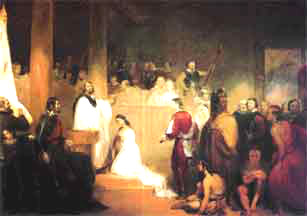Virginia

Pocohontas
Approximately 15,000 Algonquian Indians had previously settled the area that became before the English arrived. The Algonquians lived primarily along the Rivers of Virginia.
The British directed their first efforts settling Virginia into creating the Roanoke settlement. The pioneers of that settlement disappeared and were never heard from again. The first English settlement to succeed was the Jamestown colony. The Virginia Company settled Jamestown in 1609. Initially, the Virginia Company held the charter to settle all of North America. The area of their charter was slowly decreased over the years to include only what became the states of Virginia and West Virginia.
The Jamestown settlement struggled initially. The friendships settlers developed with the local natives were essential to saving Jamestown. The native Indians chose to lend their helping hands, primarily, thanks to Pocahontas, the daughter of the chieftain Powhatan. Pocahontas was able to finesse the end of the first Anglo-Powhatan War. However, it was the development of the Tobacco crop by John Rolfe that provided the economic foundation for the colony. Tobacco was highly profitable for the colony. Growing tobacco helped the colonies develop economic independence. A second war developed with the Powhatan in 1622. The settlers mounted a surprise attack, to the tribe’s shock and disbelief. The Indians were eventually defeated.
Tobacco growing became incredibly successful. The Virginia Company believed the colonists were getting too dependent on that crop. As a result, the Virginia Company tried to limit how much tobacco each colonist could grow. This caused a near revolt among the colonists. A royal investigation of the company was initiated. Consequently, the Virginia Company’s charter was suspended. The company was dissolved in 1625. From that point on the governor of Virginia was appointed by the British monarchy. As the colony expanded a wealthy tobacco growing elite developed. The Tobacco elite soon dominated both Virginia politics and its economy. Initially, colonists could influence the governors through the Governor’s Council, where elite members of the community served. Slowly, however, the House of Burgesses and the local Virginia legislature eclipsed the power of the Governor’s Council.
In 1675, there was a brief moment of rebellion in the colony. Nathaniel Bacon, a new arrival from England, demanded a commission to attack Indians. A confrontation ensued when Bacon chose to do so without permission. Bacon soon led a full-fledged revolt against the then long-term governor, Lord William Berkeley. Berkeley was forced to flee Jamestown, which had burned down. Bacon died suddenly and the revolt petered out. It’s not clear what the end result of the full rebellion might have been. Berkeley decided to retire.
Slaves first were brought into Jamestown in 1619. At first, the slaves worked as indentured servants, under contract for a set period of time. Through much of the 17th century indentured servants (who eventually gained their freedom) did most of the labor in the Virginia colony. By the end of the century, however, that began to change dramatically– as Virginia began to rely more and more on slave labor. In 1705, the Virginia Legislature passed a law that became known as the “Slave code”. The “Slave Code” officially classified the status of slaves as slaves.
Churches were at the center of communal life in the early years of the colony. During that time the only form of Christianity practiced in Virginia was that of the Church of England. After the Great Awakening in 1740 additional forms of Christianity began to be practiced in Virginia.
Virginians played a key role in the confrontations that developed between the English government and the colonists in the years leading up to the Revolutionary War. While there were no direct confrontations, (like those that took place in Boston), leading Virginians became leaders in the cause for Independence.
 >
>